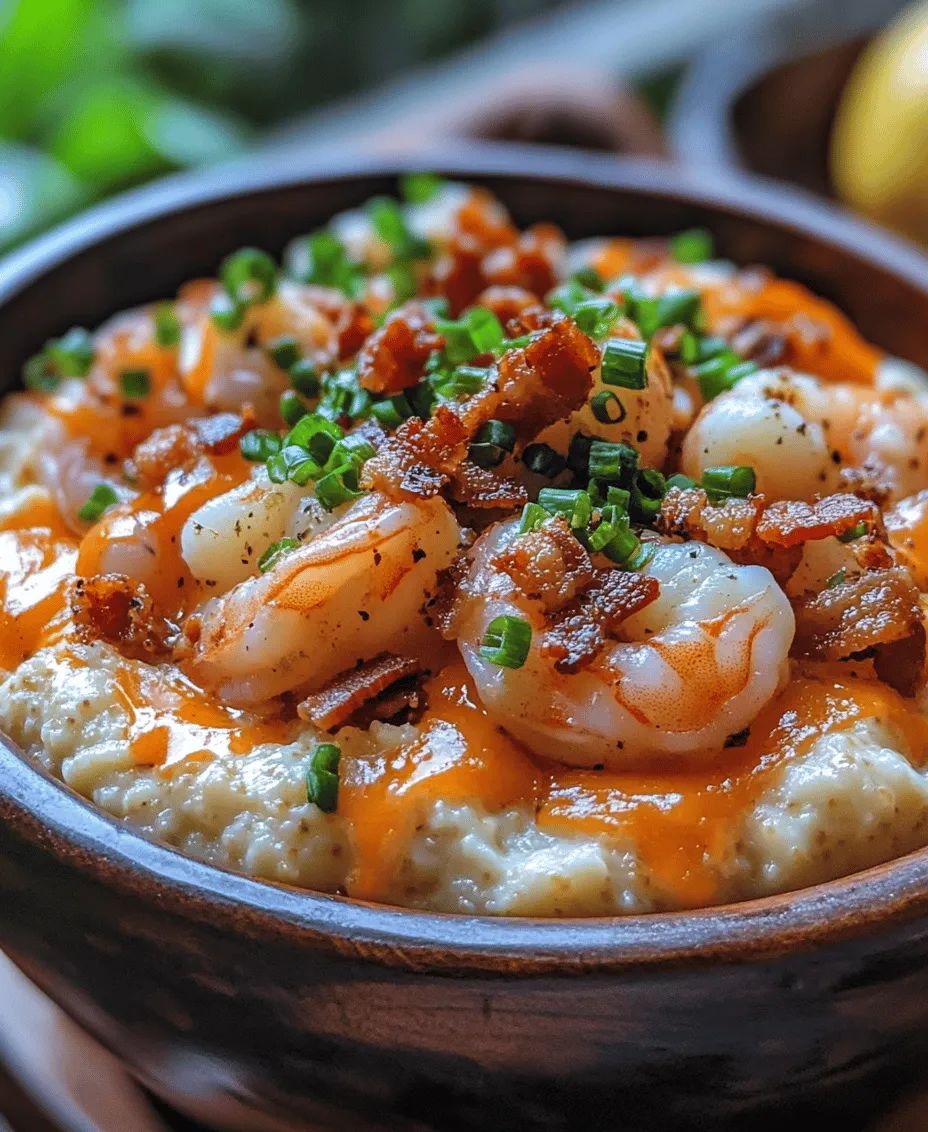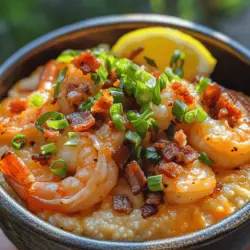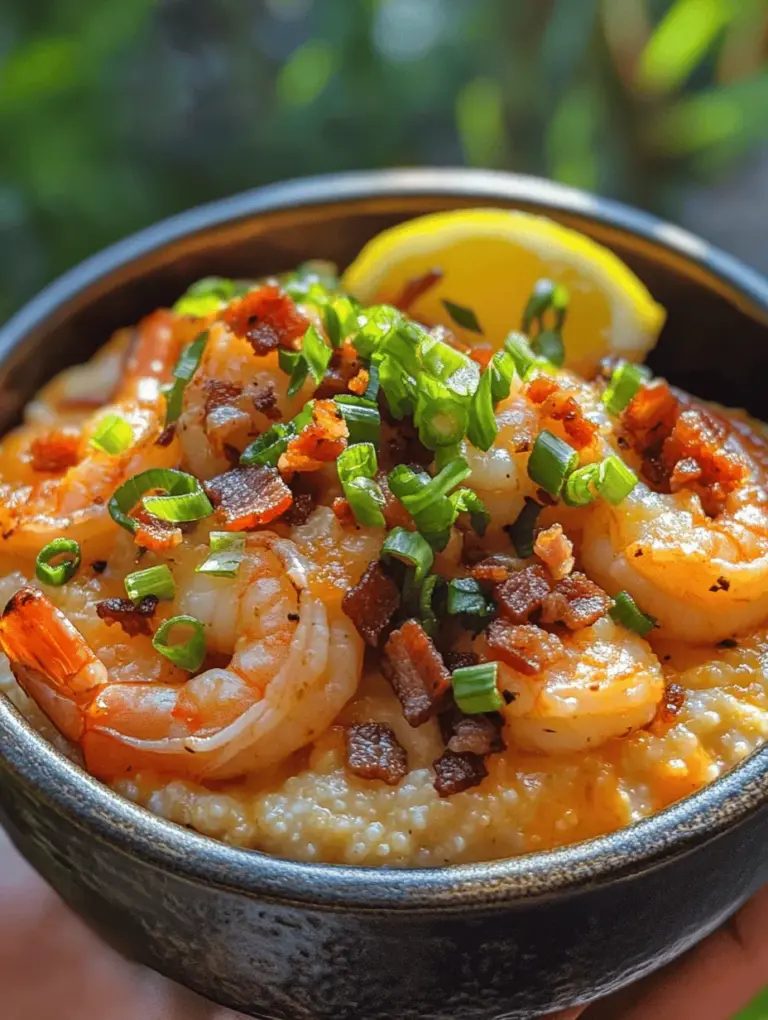Introduction
Shrimp and Grits is a beloved staple of Southern cuisine, known for its rich flavors and comforting textures. This dish perfectly embodies the essence of Southern cooking, where the combination of fresh seafood and creamy, buttery grits creates a symphony of taste that warms the heart and soul. Whether served as a hearty breakfast, a delightful brunch, or an indulgent dinner, Shrimp and Grits brings together the best of coastal flavors with the rustic charm of Southern fare.
The popularity of this dish has soared in recent years, finding its way onto menus in restaurants across the country, and for good reason. It’s not just a meal; it’s an experience. The harmony of succulent shrimp sautéed in a savory sauce served over a bed of creamy grits resonates with both nostalgia and modern culinary appreciation. Best of all, making Shrimp and Grits on the stovetop is incredibly easy, allowing home cooks of all skill levels to bring a taste of the South to their dining tables.
Understanding Shrimp and Grits
Historical Context and Origins
The origins of Shrimp and Grits can be traced back to the Lowcountry of South Carolina and Georgia, where Native Americans first cultivated corn, which was ground into grits. Traditionally, this dish was a simple breakfast made by fishermen who would cook shrimp caught from the coastal waters with corn grits. It was a practical meal, utilizing readily available ingredients and designed for sustenance.
Over time, Shrimp and Grits evolved from its humble beginnings into a celebrated dish that reflects the rich culinary heritage of the South. The incorporation of various seasonings and cooking techniques transformed it into a restaurant-worthy entrée, showcasing the depth of flavor that can be achieved with just a few key ingredients. Today, Shrimp and Grits are enjoyed in homes and eateries alike, often with regional variations that highlight local ingredients and flavors.
Cultural Significance in Southern Cuisine
Shrimp and Grits is more than just a meal; it’s a symbol of Southern hospitality. The dish encapsulates the warmth and generosity associated with Southern culture, often served at family gatherings, celebrations, and communal dinners. It’s a dish that brings people together, fostering a sense of community and togetherness. Many families have their own unique recipes passed down through generations, each adding personal touches that reflect their heritage and traditions.
In addition to its cultural significance, Shrimp and Grits showcases the bounty of the South, particularly the abundant seafood and farmland. It represents the connection between land and sea, highlighting the importance of local ingredients and seasonal cooking. This dish has become a canvas for creativity, allowing chefs and home cooks to experiment with flavors while honoring its rich history.
Nutritional Benefits of Shrimp and Grits
Not only is Shrimp and Grits a delicious dish, but it also offers several nutritional benefits. Shrimp is an excellent source of protein, low in calories, and packed with essential nutrients, including selenium, vitamin B12, and omega-3 fatty acids. The combination of shrimp and grits provides a balanced meal, delivering both protein and carbohydrates that can fuel your day.
When made with stone-ground grits, this dish also offers dietary fiber, which is important for digestive health. Incorporating ingredients like garlic and green onions adds additional vitamins and antioxidants, enhancing the overall health profile of the meal. By choosing high-quality ingredients and preparing it with care, Shrimp and Grits can be a nutritious and fulfilling dining option.
Ingredients Overview
Creating the perfect Shrimp and Grits requires attention to detail, particularly when it comes to selecting your ingredients. Here’s a closer look at each component that makes this dish exceptional:
Stone-Ground Grits
The foundation of any great Shrimp and Grits is the grits themselves. Opt for stone-ground grits if possible, as they offer a superior texture and flavor compared to instant or quick-cooking varieties. Stone-ground grits are less processed and retain more of the corn’s natural flavor, resulting in a creamier, more satisfying dish. The cooking process for stone-ground grits may take longer, but the payoff in taste is well worth the effort.
Chicken Broth vs. Water
When cooking grits, the choice of liquid significantly impacts flavor. Using chicken broth instead of water infuses the grits with a rich, savory taste that elevates the dish. Broth adds depth and enhances the overall profile, making each spoonful more satisfying. For a vegetarian option, vegetable broth can be used to achieve similar results.
Sharp Cheddar Cheese
To achieve the creaminess and flavor that Shrimp and Grits is known for, sharp cheddar cheese is essential. The tangy notes of sharp cheddar complement the sweetness of the shrimp and the richness of the grits. Incorporating cheese into the grits not only enhances the dish’s flavor but also adds a delightful creaminess that ties all the elements together.
Unsalted Butter
Butter plays a crucial role in the richness and texture of the dish. Unsalted butter allows you to control the saltiness of the recipe while adding a smooth, velvety mouthfeel to the grits. It also enhances the overall flavor profile, making each bite indulgent and satisfying.
Shrimp
The star of the dish is, of course, the shrimp. When selecting shrimp, look for fresh or frozen shrimp that are wild-caught if possible, as they tend to have a more robust flavor compared to farmed shrimp. Additionally, pay attention to the size of the shrimp; larger shrimp (16-20 count per pound) are ideal for this recipe, as they provide a satisfying bite and a meaty texture.
Bacon
Adding bacon to the dish introduces a delightful smokiness and depth of flavor that elevates the overall experience. The rendered bacon fat can also be used to sauté the shrimp, infusing them with additional richness. For a healthier option, turkey bacon or pancetta can be used as substitutes.
Garlic, Smoked Paprika, and Red Pepper Flakes
Flavor enhancers such as garlic, smoked paprika, and red pepper flakes are essential for building a robust flavor profile. Garlic adds depth, while smoked paprika brings a subtle smokiness that enhances the dish’s comforting nature. Red pepper flakes introduce a hint of heat, balancing the richness of the grits and the sweetness of the shrimp.
Green Onions
Green onions add a fresh element to the dish, both in terms of flavor and presentation. They provide a mild onion flavor that complements the richness of the grits and shrimp. Slicing them thinly and using them as a garnish adds a pop of color and freshness, making the dish visually appealing.
Salt and Pepper
Finally, salt and pepper are essential seasonings that bring balance to the dish. Proper seasoning enhances the flavors of all the ingredients, ensuring that each component shines through. Adjust the seasoning to your taste, but remember that it’s easier to add more later than to take it away.
Step-by-Step Cooking Process
Now that you’re familiar with the ingredients, let’s dive into the cooking process for this easy stovetop Shrimp and Grits recipe. Follow these detailed instructions to create a delicious and satisfying meal that will impress your family and friends.
Step 1: Prepare the Grits
1. Choose Your Equipment: Start by selecting a medium saucepan, which will allow for even cooking of the grits.
2. Measure the Liquid: For every cup of stone-ground grits, you’ll need approximately four cups of chicken broth (or water).
3. Bring to a Boil: Pour the chicken broth into the saucepan and bring it to a rolling boil over medium heat.
4. Add the Grits: Once the broth is boiling, slowly whisk in the grits to prevent clumping. Stir continuously until all the grits are added.
5. Reduce Heat and Simmer: Lower the heat to a gentle simmer and cover the saucepan. Cook the grits for about 20-25 minutes, stirring occasionally. The goal is to achieve a creamy consistency, so keep an eye on them to avoid sticking.
6. Incorporate Cheese and Butter: Once the grits are cooked to your liking, remove them from heat and stir in a generous amount of sharp cheddar cheese and a few tablespoons of unsalted butter. This will add richness and creaminess to the grits. Season with salt and pepper to taste.
Step 2: Cook the Shrimp
1. Prepare the Shrimp: If using frozen shrimp, make sure to thaw them in the refrigerator or under cold running water. Peel and devein the shrimp, removing the tails if desired. Pat them dry with paper towels to remove excess moisture.
2. Cook the Bacon: In a large skillet over medium heat, add diced bacon or pancetta. Cook until crispy, about 5-7 minutes. Once done, remove the bacon from the skillet and set it aside, leaving the rendered fat to sauté the shrimp.
3. Sauté the Shrimp: In the same skillet, add the prepared shrimp in a single layer. Sauté them for about 2-3 minutes on one side until they turn pink and opaque.
4. Add Flavorings: Flip the shrimp over and add minced garlic, smoked paprika, and red pepper flakes. Continue to cook for an additional 1-2 minutes, ensuring the shrimp are fully cooked and coated in the flavorful seasonings.
5. Finish with Bacon and Onions: Stir in the crispy bacon and sliced green onions, reserving a few for garnish. Allow everything to cook together for an additional minute, allowing the flavors to meld.
Step 3: Assemble and Serve
Once the shrimp are cooked and the grits are creamy, it’s time to assemble your dish. Spoon a generous portion of grits onto each plate, topping them with the sautéed shrimp mixture. Garnish with additional green onions for a fresh touch, and enjoy this comforting Southern classic that is sure to delight your taste buds.
With these easy steps, you’ll have a delicious stovetop Shrimp and Grits dish that captures the heart of Southern cuisine, making it a perfect addition to your culinary repertoire. Stay tuned for the next part, where we will explore tips for achieving the best results and answer some common questions about this classic dish.

Importance of Stirring and Adjusting Consistency
When making grits, one of the most crucial factors is achieving the right consistency. Grits can quickly go from perfectly creamy to overly thick if left unattended. As you cook, make sure to stir the grits frequently. This not only prevents them from sticking to the bottom of the pot but also ensures that the grains cook evenly.
If you find that your grits are too thick, don’t hesitate to adjust the consistency by adding a splash of milk or water. This will help create a smoother texture without compromising the flavor. On the other hand, if your grits are too watery, allow them to simmer a bit longer, stirring continuously until they reach that desired creamy perfection.
Adding Cheese: Techniques for Achieving a Creamy Texture
Cheese is a game-changer when it comes to enhancing the flavor and creaminess of your grits. For a classic Southern-style shrimp and grits, using sharp cheddar cheese is a popular choice. To incorporate the cheese seamlessly into your dish, follow these techniques:
1. Grate Your Cheese: Always opt for freshly grated cheese instead of pre-packaged shredded cheese. Pre-packaged varieties often contain anti-caking agents that can prevent the cheese from melting smoothly.
2. Add Cheese at the Right Moment: Once your grits have reached a creamy consistency, remove them from the heat before stirring in the cheese. This helps to avoid overheating the cheese, which can lead to a greasy texture.
3. Stir Until Fully Melted: Gently stir the cheese into the hot grits until it melts completely. You want to achieve a luscious, creamy texture that envelops each grain of grit.
Preparing the Shrimp: Cooking Bacon and Utilizing the Fat
Preparing the shrimp is just as important as making the grits. Start by cooking some bacon in a large skillet over medium heat. The bacon not only adds a savory flavor to the dish but also provides a rich fat that will enhance the shrimp.
1. Cook the Bacon: Chop the bacon into small pieces and cook until crispy. This should take about 5-7 minutes. Once done, remove the bacon pieces from the skillet, leaving the rendered fat behind.
2. Sauté Aromatics: In the same skillet with the bacon fat, you can add diced onions, bell peppers, and garlic. Sauté these ingredients until they become fragrant and tender—this will take about 3-5 minutes.
3. Add the Shrimp: After the aromatics have softened, it’s time to add your shrimp. Make sure to peel and devein them beforehand. Cook the shrimp for about 2-3 minutes on each side until they turn pink and opaque.
Perfectly Cooking Shrimp: Tips for Achieving the Right Texture
Getting the shrimp cooked perfectly can elevate your shrimp and grits to another level. Here are some essential tips:
1. Choose the Right Shrimp: Use large, fresh shrimp for the best texture. If using frozen shrimp, ensure they are fully thawed and patted dry to avoid excess moisture.
2. Don’t Overcrowd the Pan: When cooking shrimp, make sure not to overcrowd the skillet. This allows the shrimp to sear properly rather than steam, resulting in a better texture.
3. Look for Color Changes: Watch for the shrimp to turn from grey to pink and curl slightly. This typically indicates they are done. Remove them from the heat promptly to prevent overcooking.
Combining the Ingredients: Ensuring Even Distribution of Flavors
Once your grits and shrimp are perfectly cooked, it’s time to combine them. Start by adding the cooked shrimp and any remaining juices from the skillet into the pot of grits.
1. Mix Gently: Use a spatula or spoon to fold the shrimp into the grits gently. Be careful not to overmix, as this can break the shrimp apart and alter their texture.
2. Adjust Seasoning: Taste your dish and adjust the seasoning as necessary. You might want to add salt, pepper, or a dash of hot sauce for an added kick.
3. Serve Immediately: For the best flavor and texture, serve your shrimp and grits immediately while they are hot.
Tips for Perfecting Your Shrimp and Grits
Common Mistakes to Avoid When Cooking Grits
– Not Using Enough Liquid: Ensure the water-to-grits ratio is correct to avoid dry grits.
– Skipping the Stirring: Stir frequently to prevent clumps and ensure even cooking.
– Using Instant Grits: Opt for stone-ground or regular grits for better flavor and texture.
How to Know When Shrimp is Perfectly Cooked
– The shrimp should be pink and opaque. They should also have a slight curl but not be tightly curled, which can indicate overcooking.
Adjusting Spice Levels: Personalizing the Dish to Taste
– Feel free to add spices like Cajun seasoning, smoked paprika, or red pepper flakes to customize the heat levels to your liking.
Incorporating Variations: Options for Adding Vegetables or Different Proteins
– Consider adding sautéed spinach, tomatoes, or corn for added nutrition and flavor. You can also substitute shrimp with chicken or sausage for a different protein option.
Serving Suggestions
Ideal Accompaniments for Shrimp and Grits
– Pair your shrimp and grits with a side salad or roasted vegetables for a balanced meal.
Presentation Tips for an Appealing Dish
– Use a shallow bowl to serve your shrimp and grits. Spoon the grits into the center and layer the shrimp on top. Garnish with chopped fresh parsley or green onions for a pop of color.
Ideas for Pairing with Beverages
– A crisp white wine, such as Sauvignon Blanc or a light beer, pairs beautifully with shrimp and grits. For non-alcoholic options, consider iced tea or lemonade.
Nutritional Information
Breakdown of Calories and Nutrients Per Serving
– A standard serving of shrimp and grits contains about 500-600 calories, depending on the portion of cheese and bacon used.
Health Benefits of the Main Ingredients
– Shrimp is low in calories and high in protein, while grits provide whole grains, offering fiber and essential nutrients. Cheese adds calcium and additional protein.
How to Make the Dish Healthier if Desired
– To lighten the dish, consider using low-fat cheese or substituting bacon with turkey bacon. You can also increase the vegetable content for added fiber and nutrients.
Conclusion
Easy Stovetop Shrimp and Grits is a fantastic dish that combines creamy grits with succulent shrimp, creating a comforting meal perfect for any occasion. Its versatility allows for personal touches, whether you prefer to keep it classic or add your twist with different spices or vegetables. The ease of preparation makes it an ideal choice for family dinners or entertaining guests.
Encourage your friends and family to gather around the table and enjoy this delightful dish together. With its rich flavors and creamy texture, shrimp and grits is sure to become a favorite in your culinary repertoire. So, roll up your sleeves, gather your ingredients, and get ready to savor every bite of this Southern classic.

